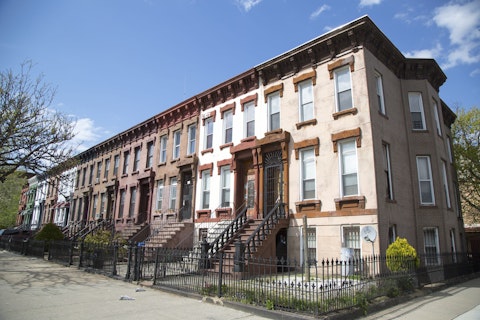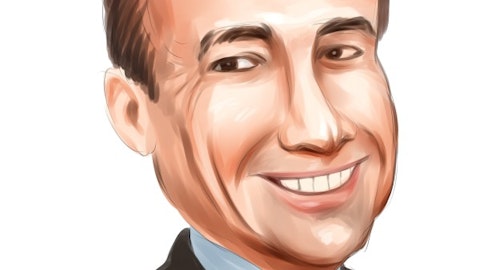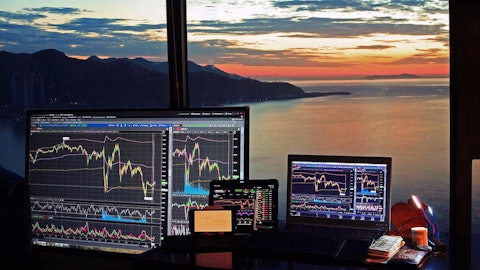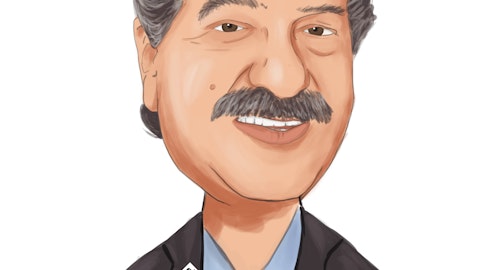Apogee Enterprises, Inc. (NASDAQ:APOG) Q1 2024 Earnings Call Transcript June 23, 2023
Apogee Enterprises, Inc. beats earnings expectations. Reported EPS is $1.05, expectations were $0.9.
Operator: Good day and thank you for standing by. Welcome to the First Quarter 2024 Apogee Enterprises’ Earnings Conference Call. At this time, all participants are in a listen-only mode. After the presentation, there will be a question-and-answer session. [Operator Instructions] Please be advised that today’s conference is being recorded. I would now like to hand the conference over to your speaker today, Jeff Huebschen, Vice President of Investor Relations. Please go ahead.
Jeff Huebschen: Thank you, Liz. Good morning and welcome to Apogee Enterprises fiscal 2024 first quarter earnings call. With me today are Ty Silberhorn, Apogee’s Chief Executive Officer; and Matt Osberg, Chief Financial Officer. I’d like to remind everyone that there are slides to accompany today’s remarks. These are available in the Investor Relations section of Apogee’s website. During this call, we will reference certain non-GAAP financial measures. Definitions of these measures and a reconciliation to the nearest GAAP measures are provided in the earnings release and slide deck we issued this morning. I’d also like to remind everyone that our call will contain forward-looking statements. These reflect management’s expectations based on currently available information.
Actual results may differ materially. More information about factors that could affect Apogee’s business and financial results can be found in today’s press release and in our SEC filings. And with that, I’ll turn the call over to you, Ty.
Ty Silberhorn: Thank you, Jeff. Good morning, everyone. Well, Apogee’s team delivered yet another strong quarter. Our strategy and strengthening operational execution continue to drive results. This morning, I’ll cover highlights from the quarter, how our strategy is driving sustainable improvements in our business, and our progress on this year’s priorities. Then I’ll turn it over to Matt for more details on the quarter and our outlook. The first quarter was a solid start to our fiscal year, continuing the positive trends we’ve established over the past several quarters. We delivered top and bottom line [Technical Difficulty] sustained operating margins at 9.3% and had a strong cash flow quarter with cash from operations significantly higher than last year’s first quarter.
These improved financials are underpinned by the strengthening operational execution across our businesses. We are successfully managing the things that we can control. We’re driving sustainable [Technical Difficulty] improvements through the Apogee Management System. We’re maintaining a strong focus on cost management. We’re improving key processes and systems across the company, and we’re bringing more rigor and focus to how we are managing the business. Looking at the segments, our [Technical Difficulty]. Our glass team continued their [Technical Difficulty]. I’d more to say about transformation of our Glass business in a moment. [Technical Difficulty] and large scale optical also had solid quarters with strong execution, offset inflation, and improved sales mix as we continue to emphasize differentiated product offerings.
Results in Architectural Services came in below our expectations [Technical Difficulty] to work through a transition to better position the business for long-term growth and manage lower than expected profitability [Technical Difficulty]. We remain confident in our [Technical Difficulty] potential of the business. Our Harman brand is a recognized leader in its industry with a strong market position and broad set of capabilities. As a reminder, in recent years, services has outperformed its market and we’re confident we will see improved performance as we move through this fiscal year. Even with the softer than expected results and services, the first quarter was a strong start to our fiscal year, with our glass business outperforming the market due to their shift to premium and we their continued operational execution.

Copyright: zhukovsky / 123RF Stock Photo
We are well-positioned to build on our success from this quarter and increasing our full-year earnings outlook. Our improved performance continues to be driven by our three pillar strategy referenced on Slide 5 in our presentation. The performance of Architectural Glass over the past two years is a great case study of our strategy at work. Page 6 highlights the Glass segments transformation. Operating under the Viracon brand, our Glass business has long been an industry leader. We have a reputation for quality and service, deep relationships with customers and influencers and a wide range of capabilities, including proprietary products. Even with those strengths, the Glass segment had underperformed its potential. Through our strategy work, we identified two imperatives for change.
We needed to build a more competitive cost structure sustaining it with productivity, and we needed to shift our focus to the premium segment of the market that recognizes the value we provide. The team has achieved tremendous success in both areas. We’ve driven sustainable productivity improvements through the deployment of the Apogee Management System. Our approach to lean and continuous improvement. Additionally, our facility rationalization reduced our overall cost structure without impacting our ability to serve customers in our target markets. We repositioned the business as a leader in premium solutions and we aligned the entire organization to better serve this market. This included changes to our sales organization, leveraging innovation and partnerships to deepen our product offerings, and driving improvements in quality, service, and delivery to outperform customer expectations.
This shift in market focus has led a more favorable sales mix, improved pricing for the value we offer our customers, and new growth opportunities. The progress with our strategy is evident in our financial results. The team has delivered impressive margin gains and positioned the business now as an economic leader. Based on this progress, we are increasing our target margin range for Glass as shown on Slide 7. Our new target margin range is 10% to 15% on a full-year basis, compared to our previous range of 7% to 10%. It’s very encouraging that this quarter, three of our four business segments delivered margin above the target ranges we set at our Investor Day, especially given that we are still early in our AMS journey. As we move through fiscal 2024, our strategic framework positions us for further progress toward our financial targets, and positions us to outperform throughout the market cycle.
While overall non-residential construction activity remains healthy today, there are reasons for a somewhat cautious view of the market as we move forward. Higher interest rates, along with overall economic uncertainty may impact construction activity for at least some period. However, through our team’s efforts, we are transforming Apogee into a higher performing, more resilient company. I’m confident that we would drive further performance gains as the year progresses. Page 8 outlines our priorities for the fiscal year, which we introduced last quarter, and this is where we will continue to focus for the remainder of the year. Our entire team is aligned on driving further progress to advance our strategy and to deliver continued [Technical Difficulty].
Now, I’d like to introduce Matt Osberg. Matt joined us in late April, and I’m very excited to have him as part of the team. He brings terrific experiences and perspectives, and he’s established a strong record of creating value throughout his career. Let me turn it over to Matt to provide more details on the quarter and our outlook.
Matt Osberg: Thanks, Ty, and good morning, everyone. I’m very excited to be part of the Apogee team and the opportunities we have as a company to continue to drive shareholder value. I look forward to speaking with many of you in the coming quarters. Before I review the results for the first quarter and our updated fiscal 2024 outlook, I want to take the chance to recognize Mark Augdahl, for the work he did in the Interim CFO role. Mark did a fantastic job leading the company through a time of transition and he has been extremely valuable to me as I have onboarded with the company. Great job Mark and thank you. Now turning to our results for the quarter. The first quarter was a strong start to our fiscal year, building on the momentum established last year.
Consolidated net sales grew 1.4% to $361.7 million. The increased sales were primarily driven by strong growth in Glass, which was up 27.5%, compared to the prior year. As expected, this was [partly offset] [ph] by a net sales decline of 13.5% in services, [14%] [ph] in the first quarter of fiscal 2023. Consolidated operating income increased 1.7%, primarily driven by strong sales and margin improvement in Glass. The Glass segment’s operating margin was 17%, over a 10 percentage point improvement, compared to the first quarter of last year and reflects the impact not only of higher volume, but also benefits from pricing and mix as we execute our strategic shift to emphasize premium high performance products. This result also demonstrates the significant operational progress that has been made with our initial deployment [in AMS] [ph].
At a consolidated level, the Glass margin improvement was offset primarily by segment margin declines in framing and services. As a reminder, in the first quarter of last year, framing had an approximately $4 million benefit related to the timing of pricing actions and inventory flows. Last spring, as aluminum prices spiked, we were able to realize the benefit of higher selling prices as we work through lower cost aluminum inventory. Setting aside this benefit, the framing operating margin this quarter was roughly in-line with the prior year. Services had an operating loss of $0.6 million, primarily due to lower estimated profitability levels on a [selected number] [ph] of projects that are nearing completion, the impact of lower project volume, and approximately $1 million of severance costs as we continue to execute our strategic transition in the services business.
As Ty mentioned, we remain confident in the services long-term potential and expect the operating performance trend to improve as the year goes on. Diluted EPS grew 5% to $1.05, primarily driven by higher operating income, a lower effective tax rate, and a lower diluted share count, which reflects the benefit of our share repurchase activity. This was partially offset by higher interest expense, primarily due to higher interest rates. Our tax rate in the quarter was 25%, roughly in-line with our long-term rate assumption [Technical Difficulty]. Turning to our cash flow and the balance sheet, we generated $21.3 million [Technical Difficulty] improvement of $52 million over the first quarter of last year. This was primarily driven by improved [Technical Difficulty] quarter of last year had unfavorable working capital impacts related to sales growth and inflation.
[Technical Difficulty] typically our lowest quarter for cash flow [Technical Difficulty] capital expenditures of $7.4 million in the first quarter, primarily relating to investments to expand capacity in our higher margin businesses, enhance productivity through automation, and deploy improved systems to better support our business. We also returned over $10 million in cash to shareholders through dividends and [Technical Difficulty] balance sheet remains very strong with net leverage ratio, the one-time trailing 12-month EBITDA, and no significant debt maturities until 2027. Looking at backlog trends for the quarter, backlog for framing was $221 million, compared to $243 million in fourth quarter of last year. Several factors are impacting framing backlog.
First, we’ve improved service levels for our short lead time products, so we are converting backlog into sales more quickly. Second, as a part of our strategic shift, we continue to move away from lower margin sales that we would have pursued in the past. Finally, we continue to see choppiness in bidding and award activity. Services finished the quarter with $709 million in backlog. This was a slight sequential decline compared to the fourth quarter of last year, but 4% higher than the first quarter of prior year. Turning to our updated fiscal year outlook. We are pleased to be able to increase our full-year diluted EPS outlook to a range of $4.15 to $4.45, primarily reflecting our strong first quarter results and an improved outlook for our second quarter.
This updated outlook [Technical Difficulty] at the bottom of the range of approximately 4% and EPS growth at the top of the range of approximately 12%, compared to last year’s EPS of $3.98. Our outlook includes our continued expectation of net sales for the year to be flat to slightly down, reflecting lower volumes and services and framing, partially offset by growth in Glass. Also, our outlook range contemplates the latest market forecast, which point to a potential slowdown in non-residential construction in the second half of our fiscal year. Despite our sales outlook, we expect to drive EPS growth through expanded operating margins. Although the 17% operating margin in Glass this quarter is likely not sustainable for the full-year, we are increasing our margin expectations for Glass to be in the 10% to 15% range for the year, which is well above last year’s level.
Services margins should improve as we move through the year, but are expected to fall short of their 7% to 9% target range. Although framing margins are projected to decline compared to prior year, we expect margins near the top of its 9% to 12% range. Finally, we expect LSO margins to be slightly down, compared to last year. We continue to expect an average tax rate of approximately 24.5% and full-year capital expenditures of $50 million to $60 million. We also expect both operating and free cash flow growth for the year. As a reminder, fiscal 2024 is a 53-week year with an extra week of operations in the fourth quarter. For the full-year, the extra week will add approximately 2 percentage points of growth to revenue. In closing, I am pleased with our first quarter performance and ability to raise our outlook for the year.
Advancing our strategic objectives is driving improved profitability even in a year with sales growth headwinds. This improved profitability will position us to better outperform throughout the market cycle. Additionally our strong cash flow and low leverage position are enabling us to deploy capital to invest in our business and return cash to shareholders through dividends and share repurchases. We also continue to look for accretive acquisition opportunities that would accelerate our growth and profitability. I’m glad to be part of the Apogee organization and excited to contribute to the work the team is doing to drive value for all our stakeholders. With that, I’ll turn it back over to Ty for some concluding remarks.
Ty Silberhorn: Thanks, Matt. To wrap up, I want to reiterate how proud I am of the team for delivering another strong quarter and a great start to our fiscal year. We continue to make progress advancing our strategy and improving operational execution. I’m particularly happy with the performance of our Glass segment and our increased long-term outlook for that business. Through our team’s efforts across all of Apogee, we are well-positioned to continue our progress in the coming quarters. With that, we are ready to take your questions.
See also 15 Best Places to Retire in South Carolina and 16 Easiest Second Languages To Learn For English Speakers.
Q&A Session
Follow Apogee Enterprises Inc. (NASDAQ:APOG)
Follow Apogee Enterprises Inc. (NASDAQ:APOG)
Operator: [Operator Instructions] Our first question comes from the line of Chris Moore with CJS Securities.
Chris Moore: Hey, good morning, guys. I’m not – the line cutting in out a little bit, but hopefully you can hear me.
Ty Silberhorn: We hear you, Chris. Good morning.
Chris Moore: All right. Terrific. Good morning. Yeah. Maybe we could just start with Glass. Obviously, you know, revenue and margin is way above what we were expecting as highest Glass revenue since, I think, Q4 2020. I get that, you know, kind of the better mix and pricing, but you also, Ty talked about, you know, more growth opportunities, and maybe you could just expand on that a little bit?
Ty Silberhorn: I think as we’ve repositioned that business, Chris, with that focus on the premium side of the market, it’s gotten that business back to really focusing on where they can differentiate from a competitive standpoint. So, if you look at it from a top and volume level. There’s volume growth obviously in that, but what it’s allowing them to do is sell higher value added product offerings, which obviously as a result of that they’re able to command a higher price per square foot for those products. And they see the opportunity to build on that throughout the rest of the year. So, they’re getting a benefit of a volume lift as they focused in on parts of the market where that story holds up better from a differentiation standpoint, and they’re able to sell things at a higher price, as well as sell things with [additional higher] [ph] value add propositions in those product offerings for them to not only get the prices accordingly, but also that helps us with our margin performance.
Layering on top of that from a productivity standpoint, the team has done exceptionally well. And if you’ll recall, we said as we closed out last year, it’s going to be harder to take the big giant steps forward on the productivity side to drive that margin and we would need to see the mix shift come through. We’re seeing that mix shift coming through and that looks good as we look out for the rest of the year.
Chris Moore: Got it. No, that’s helpful. I mean, how do you think about the total addressable market in Glass currently versus are, you know, maybe a couple years ago? Is it significantly smaller and you’re just going to get a bigger share of it or just any thoughts there?
Ty Silberhorn: Well, I think from a broader market perspective, non resi construction continues to hold up. I mean, obviously, there’s talk and there’s concerns about how that plays out as calendar 2023 closes out and we get into calendar 2024. And when we worked through our strategic plan, we didn’t want the teams to talk about their market opportunity by going down smaller and smaller and defining smaller pieces of the market. We actually wanted them to continue to look at the broad market, but then point their energy and efforts to where they could capture the most value. So, we would still define it as we’re playing in that larger, broader market from a Glass glazing opportunity. However, we’re being much more focused and selective about what we go after.
So, we’ve got solid growth, top, as well as volume growth this quarter. They’re positioned to do that in terms of the volume growth. And top line growth through the year. And I would say, they’re outperforming the market on from a growth perspective right now, but they’re doing it in a segment of the market where we can capture the value.
Chris Moore: Got it. That’s very helpful. Maybe just one last one for me. On the challenges on services, so you know, you called out the impact of lower estimated profitability on certain projects. And I think that the comment was most of those will be running off in fiscal 2024, is that a fair way to look at it?





